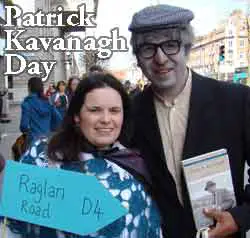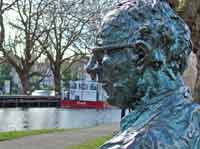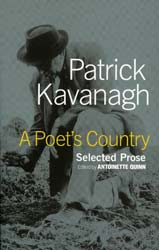Patrick Kavanagh
More great Irish writers
Patrick Kavanagh is now regarded as one of the towering figures of 20th century Irish literature.
His success, however, did not come quick or easy, nor did it bring him any great wealth. He worked as a farm labourer until he was 27, when he decided to walk the 50 miles to Dublin to meet the writer and philosopher A E Russell, who was to become his mentor.

Kavanagh had hardly any money and stayed with his brother who was a teacher in Dublin. He began to read the works of other writers such as Walt Whitman, Ralph Waldo Emerson and Robert Browning.
The work he began to produce, however, owed little to any of them and showed that Kavanagh had a voice of his own. He was appalled at the way the life of the Irish peasant was romanticised by city based writers in Ireland and elsewhere. Kavanagh had experienced the harsh reality at first hand and wanted to dispel all myths that such poverty was somehow noble and spiritually uplifting.
His first book, Ploughman and Other Poems, was published in 1936 and put forward an uncompromisingly realistic portrayal of Irish rural life. This brought a mixed reaction from the literary establishment, who begrudgingly acknowledged his talent while adopting a condescending attitude towards him, dubbing him the Peasant Poet.
The Green Fool and the Great Hunger
In 1938, he published his first novel, The Green Fool, which was a loosely autobiographical account of his transition from rural Monaghan to literary Dublin.

Kavanagh’s epic poem, The Great Hunger, was published in 1942. It is regarded by many as his masterpiece. It tells the story of an Irish farmer called Patrick Maguire and the hardships he endures as he delays marrying until he is wealthy enough to provide for a wife. That time never comes and he so he remains single and cares for his mother. The poem is like an antidote to the romanticised version of peasant life put forward by more city based writers. Maguire is not only poor; he is uneducated, and sexually and spiritually repressed.
It was a piece of work that could only be produced by a writer like Kavanagh, who had lived that life himself. By this time, Kavanagh had become disillusioned with the literary set in Dublin, who he came to see as pretentious, talentless and self-serving. He also became irritated that they insisted on still seeing him as the Peasant Poet when he, with some justification, regarded himself as an established writer of real standing. He later described how he would cringe with embarrassment when he had to walk into Russell’s house wearing his hob-nailed boots and patches on his trousers.
Despite his growing reputation, Kavanagh wasn’t making much money from his poetry and supplemented his income working as a journalist writing reviews and opinion pieces. He was also invited occasionally to give university lectures.
Tarry Flynn and Come Dance with Kitty Stobling
In 1948, Kavanagh published his novel Tarry Flynn. This was another semi-autobiographical work about an aspiring poet trying to escape the constraints of a rural community.
Actor Russell Crowe is a big fan of Kavanagh and quoted one of his poems while accepting a BAFTA award.
In 1954, Kavanagh was found to be suffering from cancer and had to have a lung removed. He made a good recovery and emerged refreshed and eager to write poetry again. He began to recuperate by walking along the banks of the Grand Canal in Dublin, which now has a statue and bench in his honour.
More poems followed including the much acclaimed collection, Come Dance with Kitty Stobling.
In 1967, Kavanagh married his long time partner, Katherine Moloney. He died later that year on 30 November in a Dublin nursing home.
Kavanagh is now regarded as one of Ireland’s greatest poets of the 20th century, while most of the fashionable literary set who derided him are long forgotten.
Patrick Kavanagh – literary giant
writers.html